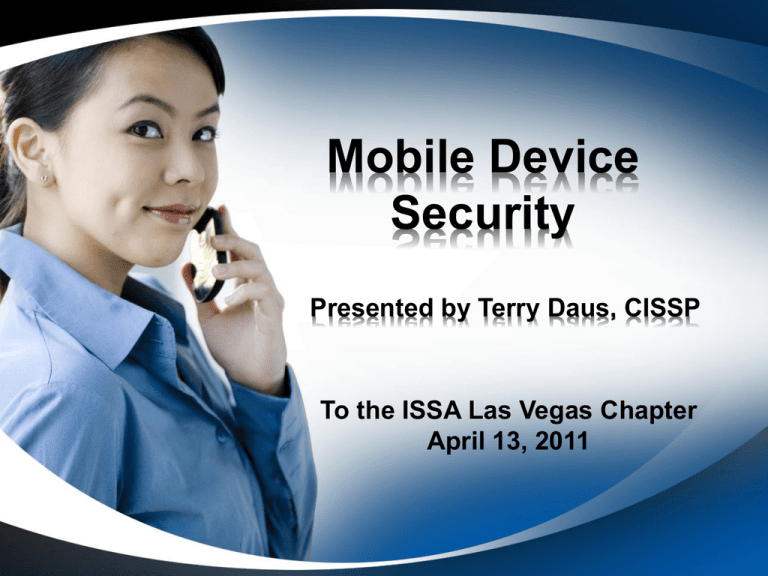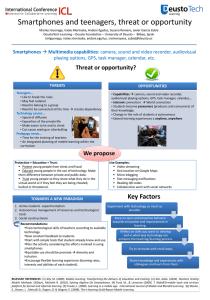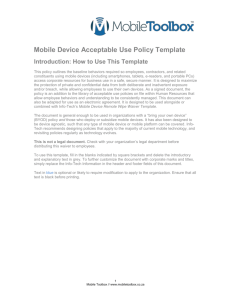Mobile Device Security - ISSA Las Vegas Chapter
advertisement

Mobile Device Security Presented by Terry Daus, CISSP To the ISSA Las Vegas Chapter April 13, 2011 Agenda • Definition • People • Technology • Policy SmartPhone Definition A cellular telephone with built-in applications and Internet access. Smartphones provide digital voice service as well as text messaging, e-mail, Web browsing, still and video cameras, MP3 player, video viewing and often video calling. In addition to their built-in functions, smartphones can run myriad applications, turning the once singleminded cellphone into a mobile computer. Source: PC Magazine Encyclopedia People What do they want? • “Only carry one” • Anywhere access • Any device supported • Transparent security Trying to Stop the Inevitable? Business What does management want? • Lower cost • Low support overhead • “Increased Productivity” • Any device supported • Transparent security Business Implications/Questions • Is the business willing to securely support a mix of personal/business data and smartphones/tablets? • Remote access - to how much? • Authority over data? • Is the value worth the cost? Policy Source: Symantec No Easy Answers • What are your organization’s compliance requirements? • Which rewards does management want to balance against risk and cost? – Compliance – Strategic mobility – Employee productivity/creativity/retention More Management Questions… • Is confidential data allowed on mobile devices? • Are personally-owned mobile devices allowed access? • Who has authority/responsibility for… – – – – – – Who gets company-issued smartphones Who gets access from smartphones, and to what? Purchasing smartphones Provisioning smartphones Securing/monitoring smartphones? Support of Organization-owned (O)? Personallyowned (P)? Standards/Operational Notes… • What are O mobile devices allowed access to? Is it different for P? • Will you list specific devices supported, or just OS versions? • Who is going to test all the new devices? How often? What about application maintenance? • (how) Do you wipe a P phone at term? • Crawl/Walk/Run or Flash Cut? Policy Design Suggestions • Review other’s policies for ideas • Review your laptop policy • Involve stakeholders in requirements and design • Communicate early and often – Stakeholders – IT (they have to make the tech work) – Finance (our buddies with the budget) – Users (they hate change too – be nice) Technology Device Scenarios • Pure Monolithic – typically BES – Organization (O) owned only • Mixed Monolithic – O or Personally (P) owned • Mail System w/Supported Security – O, O/P, limited to native OS’s • 3rd Party Mgmt Software (in-house, hosted, managed) – multiple device types Device Market Share Native Security in the OS • From Most to Least Complete Options – Blackberry – Windows Mobile (6.1 and 6.5 only) – iPhone – Android – Windows Mobile 7 – Symbian? – Nokia? Mobile Security Basic Req’mts • • • • Passwords not pins Remote wipe Secure Email/Calendar sync Device and storage card encryption Mobile Security Advanced Req’s • Disable capabilities (removable storage, camera, BlueTooth, IR, etc…) • Two-factor authentication • Failed attempts lock/wipe ActiveSync Client Comparison • Source: Microsoft - http://social.technet.microsoft.com/wiki/contents/articles/exchange-activesync-clientcomparison-table.aspx#cite_note-3 ActiveSync Client Comparison 2 • Source: Microsoft - http://social.technet.microsoft.com/wiki/contents/articles/exchange-activesync-clientcomparison-table.aspx#cite_note-3 Interesting Android Factoids • Android 2.2 supports all the basic security requirements except encryption • Android 3.0 (Honeycomb) provides encryption, but is currently only on tablets and one phone • Carriers modify Android, sometimes badly • NitroDesk Touchdown (Android Market or direct, $20) adds device and storage card encryption (3DES) to 2.2 3rd Party Security Options • Mobile Device Management (MDM) – Not just security – can have operations management and deployment capabilities • • • • Asset management Application whitelist Deploy in-house apps Deploy patches/upgrades MDM Deployment Options – Which one fits your organization better? • In-House • In-House with external comm center • Hosted • Managed Service Example MDM 1 Good Technology • Encrypts Android 2.1 and above, and iPhone 3G and above • Separation of data and apps from OS in encrypted sandbox • Can control transfer of data to personal side (contacts typically) • Onsite servers transmit through Good telecomm datacenters – no ActiveSync Example MDM 2 Mobile Iron • Suite of applications for security, asset management, and expense • Self-service portal for apps, communications search/history, and usage • Encrypts iPhones, Androids (with integrated Touchdown), integrates with BES Example MDM 3 Air-Watch • Can be purchased as a cloud service, appliance, or software • Encrypts iPhones but not Android 2.x Example MDM 4 Verizon Managed Mobility Service • 750 employee accounts minimum • Based on Sybase solutions • Services include inventory & expense mgmt, provisioning and logistics, and Sybase (policies, security, app store) • Note: Sybase did not support iOS4 or Android until Oct 2010 Can you say “complex”? CISO Mobility Challenges • Employee and management requirements often conflict • Consumer-grade products = security an afterthought or non-existent • Proprietary OS = complexity, inequality, lack of standards • Immature market = rapid change CISO Mobility Recommendations • Perform constant market research • Provide non-technical executive management enough information to make informed risk decision(s) regarding mobile devices – Immature market = limited choices, constant change – Set realistic expectations – no Holy Grail – Communicate risks in business terms – Crawl/Walk/Run Story Time – Anyone? • Hi, my name’s Terry and I’m a CISO… End? Open for Questions and Stories







